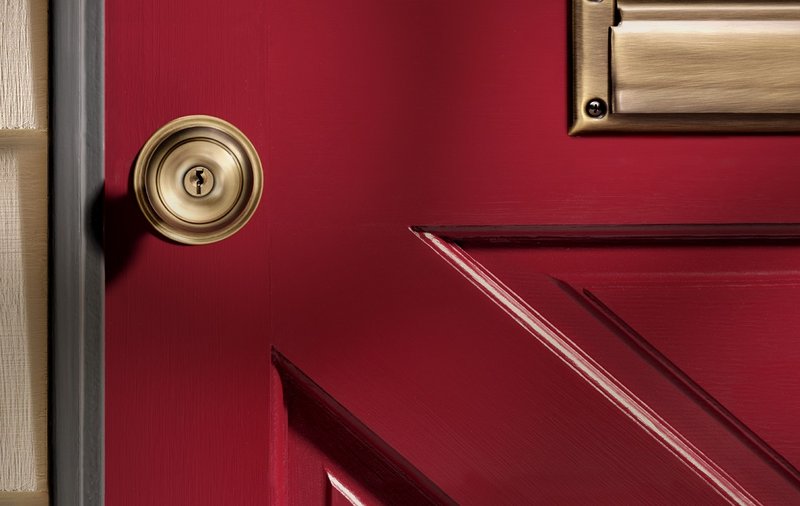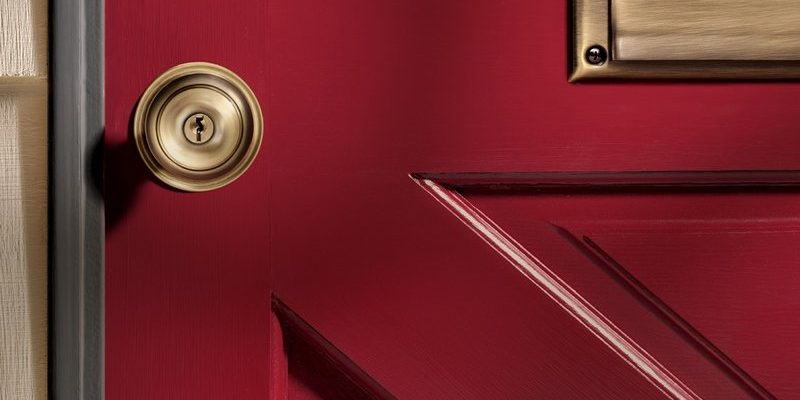
People often focus on changing batteries in their electronic locks or troubleshooting a fussy remote, but the finish—that glossy, brushed, or matte look you see and touch every day—can quietly wear away unless it’s cared for. If you want your exterior hardware to last, it’s not just about wiping it down every so often. There are a few clever, practical steps you can take to help those finishes stay sharp and reliable, no matter what brand or style you’ve picked.
Why Exterior Door Hardware Finishes Wear Out
First, let’s talk about what actually happens to your door hardware over time. It’s easy to blame rust or rain, but the truth is, a bunch of things can break down that pretty finish—sometimes faster than you think.
Weather is the biggest culprit, hands down. Sunlight, rain, snow, and even salty air (hello, coastal homes!) all team up to attack your hardware’s surface. Over time, UV rays from the sun can fade or crack the clear coating that protects metal. Water can sneak into tiny scratches or seams, leading to corrosion and that telltale spotted look. If you live somewhere humid or near the ocean, you might even spot greenish or whitish buildup, especially on brass or bronze.
Physical contact is another sneaky enemy. Every time you turn a knob, push a lever, or even just tap a keypad, your fingers leave behind oils, sweat, and small particles. These can chip away at finishes or cause discoloration—especially on cheaper or universal hardware finishes that aren’t as tough as the name brands like Baldwin or Emtek.
You might be surprised to learn that cleaners can be a problem, too. Spraying harsh chemicals, or just using the wrong cloth, can dull or scratch the surface. Some folks try to reset the shine with metal polishes meant for sinks or car parts, but that’s often a recipe for disaster. If your hardware has any electronic or smart lock parts, random sprays can also sneak into the seams and mess with batteries, code pads, or delicate circuits.
The Best Cleaning Methods for Door Hardware Finishes
Here’s the thing: cleaning your exterior door hardware isn’t just about getting rid of smudges. Done right, it’s the first step to making sure your finish lasts as long as it should.
- Go for gentle cleaning agents. Skip anything abrasive or packed with chemicals—no bleach, ammonia, or metal polish. A mix of mild dish soap and warm water is almost always your safest bet, whether you have satin nickel, oil-rubbed bronze, or chrome.
- Use a soft, damp cloth. Microfiber works wonders. Avoid paper towels or rough sponges, which can leave behind scratches (even if you can’t see them at first). For tight spots, a soft toothbrush can help.
- Dry thoroughly after cleaning. Water sitting on hardware, especially in crevices or around the backside, can lead to corrosion or spotting over time.
Honestly, if you make this a quick routine every month or so, you’ll be amazed at how much longer your finish stays looking fresh. Some brands—like Schlage or Yale—actually recommend this kind of gentle care to keep their warranty valid. And if your lock has a keypad or smart remote feature, being careful with moisture is even more important so you don’t accidentally short out the electronics or wreck the sync between components.
Protecting Finishes From the Elements
No matter where you live, your door hardware faces a lot: blazing sun, drenching rain, dust storms, even a curious dog’s nose. It’s like putting your favorite sunglasses through the washing machine—eventually, the finish takes a hit unless you shield it.
One of the easiest ways to keep your exterior hardware’s finish looking sharp is adding physical barriers. An overhead awning, storm door, or even a modest door canopy can make a huge difference. These don’t just block rain—they also keep harsh UV rays from breaking down the clear coat that protects your hardware’s shine.
If adding a canopy isn’t in the cards, try regular waxing. A little car wax or a specialty metal wax applied once every few months can add a thin, invisible layer that blocks water and slows down fading. Just be sure to avoid waxes with abrasive ingredients—stick to the ones meant for delicate surfaces.
For homes in coastal or high-humidity areas, consider swapping in hardware made for harsher conditions. Brands like Emtek and Baldwin offer finishes specifically rated for weather resistance, and some universal brands now offer marine-grade coatings. If you can’t upgrade, a bit of extra vigilance with cleaning and drying goes a long way.
Pro tip: Even the highest-rated weatherproof finish will eventually lose to the elements if ignored completely. Think of these steps as putting on sunscreen every time you go outside—your hardware will thank you.
What to Do When You Spot Damage or Wear
You might be wondering, “What if it’s already too late?” Maybe your hardware already shows signs of pitting, discoloration, or that weird white powder (yes, that’s a thing, especially on aluminum). The good news is, you don’t always have to replace everything right away.
Light tarnish or stains can often be gently buffed out with a non-abrasive pad and a dab of mild cleaning paste (again, stay far away from harsh chemical polishes unless the manufacturer says it’s okay). Go slow—rubbing too hard can strip more of the finish than you want.
Corrosion or greenish spots might call for a little more effort. Try a paste of baking soda and water, letting it sit for a few minutes before wiping away gently. If your hardware has moving parts or a battery compartment, make sure no paste seeps into areas where it could mess with the electronics or code mechanism.
In some cases, a replacement finish kit from the manufacturer can restore worn spots. For big brands like Kwikset or Schlage, these kits can help reset the finish without swapping the whole lock. Of course, if the damage is deep—think bubbling, peeling, or exposed metal—the safest long-term answer is to replace the hardware, ideally with a finish better suited to your climate.
Should You Use Aftermarket Protection Products?
Aftermarket sprays and sealants designed for metal hardware are everywhere now—just wander down the hardware aisle or browse online marketplaces. But are they worth it? And are there any risks for your finish (or your lock’s inner workings)?
Here’s my take: choose carefully. Many products promise to “restore shine” or “seal out moisture,” but some contain silicone, harsh chemicals, or even solvents that can react with the original finish. If your lock has a keypad, code entry, or rechargeable battery, make sure the spray doesn’t seep into seams or mess with the electronics.
If you go for one of these sprays, test on a hidden spot first. Watch for any dulling, bubbling, or sticky residue. And never spray directly onto the hardware—always spray your cloth, then wipe gently. Honestly, for most people, regular cleaning and car wax do the trick better (and cheaper).
If you’re a DIY type, you might also see recommendations for clear nail polish or universal acrylic sprays. These can offer a quick fix for tiny scratches but aren’t meant for exposed outdoor use. The finish can yellow or peel, and in the worst cases, trap moisture underneath.
Bottom line: When in doubt, stick with the product advice from your hardware’s original brand or manual. Aftermarket “miracle” sprays aren’t a substitute for regular maintenance.
How Proper Installation Can Protect Hardware Finishes
Let me explain why installation matters more than you think. Even the best exterior door hardware finish won’t last long if the hardware isn’t installed right. Many people rush through installation, thinking “a screw is a screw.” But those little steps make a difference for both function and finish longevity.
First, make sure all mounting screws and fasteners are snug—but not overtightened. Cranking a screw too far can crack protective coatings or cause slight misalignments that let in water around the edges. The same goes for drilling new holes: always use the right size drill bit so you aren’t forcing hardware into place, which can scrape away finish or chip paint.
Pay special attention to gaskets or backplates. These often come with weatherproof locks from brands like Schlage and Yale. They’re designed to keep moisture out and stop metal parts from rubbing directly against the door. Skipping these pieces, or accidentally pinching them during install, leaves the finish exposed to the elements—or even to battery corrosion if you have a powered lock.
Finally, after installation, give hardware a quick test to check for rattling or sticking. If you notice movement, fix it early. Loose hardware wobbles every time it’s used, which chips the finish and can even un-sync parts inside electronic locks over time.
Comparing Different Exterior Hardware Finishes
Not all finishes are created equal. If you’re picking new hardware, it pays to know which finishes hold up best outside. Here’s a quick side-by-side:
| Finish Type | Durability | Best For |
| Satin Nickel | Resists corrosion, but may show fingerprints | Most climates; modern look |
| Oil-Rubbed Bronze | Develops patina; hides wear well | Traditional homes; rustic style |
| Polished Brass | Prone to tarnish without regular cleaning | Classic style; low-exposure areas |
| Powder-Coated/Marine-Grade | Top resistance to salt, sun, and water | Coastal homes; harsh climates |
It’s worth mentioning that universal finishes on cheaper hardware may look great out of the box, but often fade or pit much faster compared to name-brand marine-grade finishes. If you’re in a tough climate, splurging for higher-quality hardware can save you from frequent replacements.
Staying Ahead: Routine Maintenance and Troubleshooting
The truth is, taking a few minutes every couple of months can save you hours (and money) down the road. Routine maintenance isn’t just about cleaning—it’s also about keeping your hardware working as it should, especially if you use any code, remote, or smart lock features.
- Set a calendar reminder to check and clean exterior hardware every 2–3 months, or more often if you live somewhere especially harsh.
- Inspect for early signs of trouble like spotting, peeling, or sticky buttons on keypads. Catching problems early usually means you can fix them before they spread.
- Check battery compartments and seals on smart locks to avoid leaks that could corrode both finish and internal parts.
- Sync or reset electronic locks as needed if you notice lags, glitches, or connection issues. Sometimes finish wear comes from pushing harder on sticky buttons or levers.
If you ever have to troubleshoot an issue—whether it’s a jam, failing code pad, or an unresponsive remote—taking care not to damage the finish while making repairs is just as important as solving the mechanical problem.
Final Thoughts: Protecting Your Investment in Curb Appeal
Exterior door hardware isn’t just about keeping your home safe—it’s about making a great first impression and avoiding hassle in the long run. By taking a little extra time for gentle cleaning, smart installation, and routine checks, you can stretch the life of your door hardware’s finish for years, no matter the brand or style you choose. Whether you’re the type to install the latest smart lock or stick with a classic brass handle, these steps help your hardware stand up to whatever the weather (or your family) throws at it. In the end, that bit of extra care means your home keeps looking sharp—and your locks keep working reliably—season after season.
